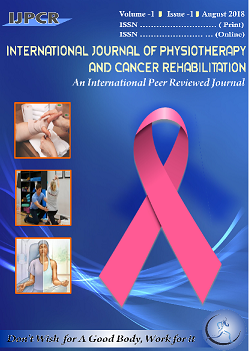International Journal of Physiotherapy and Cancer Rehabilitation
SEARCH
Our Founder
Popurlaly known as ‘jannu bhai’, the Late manishi’s vision, farsightedness and sacrifice have enabled us reach the stature we enjoy today More...Vice Chancellor's Message
It gives me immense pleasure to learn that the 1st volume of international journal of physiotherapy and cancer rehabilitation is being More...Cover Page Volume I Issue I
 .
.
IJPCR
THE NATURAL COURSE OF LOW BACK PAIN AND EARLY INTERVENTION OF HIGH RISK POPULATION.
Dr. K.K Singh Dr. Ajeet Saharan Dr. Dhruv Taneja Dr. Manoj Kumar Mathur
Abstract:
STUDY OBJECTIVES: (1) To apply the afore-mentioned methodological guidelines to the literature on community prevalence of LBP and assign an overall methodological score, (2) To compare studies determined to be methodologically acceptable in an attempt to draw conclusions about the prevalence of LBP in the world population, (3) To estimate of the point prevalence of LBP in North America, and (4) To make suggestions for improving the methodological quality of these types of studies. DESIGN:RCT. SETTING:Patients were recruited from the orthopedic clinic of a local hospital and several general practitioners‘ practices. METHODS:An RCT was performed with patients randomly assigned to 1 of 2 treatment groups: (1) a group that received general exercise combined with specific trunk muscle stabilization exercise techniques or (2) a group that received general exercise only. The research physical therapist (GAK) who was in charge of the study and who performed the outcome assessments of subjects and data analyses was unaware of group allocation throughout the study. However, the clinical physical therapist (FR) who administered the exercise programs could not bemasked to group allocation. Patients were not aware of the theoretical bases of each of the exercise regimensbecause the study‘s objective was described to them in the following way: ?to identify any differential effect between 2 exercise regimens for the trunk muscles,which have a role in protecting the spine from further injury OUTCOME MEASURE: Short-Form McGill Pain Questionnaire (SF-MPQ), visual analog scale (VAS), Roland-Morris Disability Questionnaire (RMDQ). CONCLUSION: LBP is a common and usually benign disorder, which is characterized by exacerbations and remissions. However, about 10% of the adult Danish population develops chronic or frequently recurring LBP over several years. Therefore, an effort must be made to identify a high-risk population early in order to implement selective primary preventive measures. LBP is associated with the presence of other disorders in both adults and adolescents, thus, these associations cannot be explained merely by external factors in adult life, but probably have, at least partly, a common origin based on an inherent frailty. We could not predict future LBP by birth factors, although birth weight often is associated with other diseases, but the liability to develop LBP seems to have a genetic component. It is possible that it is the individuals with a strong genetic disposition for LBP, who develop chronic/recurrent LBP in adulthood. If such an underlying genetic predisposition exists, the recurring pattern of LBP is a logical consequence. This predisposition might also indicate a general frailty making individuals more prone to other disorders as well, which would explain the associations between LBP and other disorders.
Keywords: -